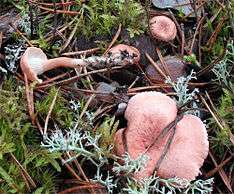Aphroditeola
| Aphroditeola | |
|---|---|
 | |
| Found in Västerbotten, Sweden | |
| Scientific classification | |
| Kingdom: | Fungi |
| Division: | Basidiomycota |
| Class: | Agaricomycetes |
| Order: | Agaricales |
| Family: | Hygrophoraceae |
| Genus: | Aphroditeola Redhead & Manfr.Binder (2013) |
| Type species | |
| Aphroditeola olida (Quél.) Redhead & Manfr.Binder (2013) | |
| Synonyms | |
|
Cantharellus olidus Quél., in Cooke & Quélet, (1878) | |
Aphroditeola is an agaric fungal genus that produces pink cantharelloid fruit bodies on coniferous forest floors. The lamellae are forked and typically the fruit bodies have a fragrant odor described as candy-like, cinnamony or pink bubble gum-like. In the last century it was classified in Hygrophoropsis, a genus in the Boletales. However, Hygrophoropsis has dextrinoid basidiospores[1][2] while Aphroditeola lacks these. Phylogenetically Aphroditeola is classified in the Agaricales near the Hygrophoraceae.[3] [4] Little is known about its biology except that the type species can be grown in culture from basidiospores and it produces pinkish to reddish-orange mycelium.[5][6] In other literature and web sites the type species is called by synonymous names Hygrophoropsis morganii or Hygrophoropsis olida or incorrectly labelled Hygrophoropsis rufescens, a misapplied name.
Etymology
The name Aphroditeola is an allusion to Aphrodite Greek goddess because of the combination of pretty pink coloration and perfume-like odor. In some literature it is known as Hygrophoropsis morganii based on the earlier classification and the incorrect presumption that the type species was named Cantharellus morganii before the name Cantharellus olidus.[6]
References
- ↑ Binder M, Hibbett DS (2006). "Molecular systematics and biological diversification of Boletales". Mycologia. 98 (6): 971–81. doi:10.3852/mycologia.98.6.971. PMID 17486973.
- ↑ Moncalvo JM, Vilgalys R, Redhead SA, Johnson JE, James TY, Catherine Aime M, Hofstetter V, Verduin SJ, Larsson E, Baroni TJ, Greg Thorn R, Jacobsson S, Clémençon H, Miller OK (2002). "One hundred and seventeen clades of euagarics" (PDF). Molecular Phylogenetics and Evolution. 23 (3): 357–400. doi:10.1016/S1055-7903(02)00027-1. PMID 12099793.
- ↑ Lodge DJ, Padamsee M, Matheny PB, Aime MC, Cantrell SA, Boertmann D, et al. (2014). "Molecular phylogeny, morphology, pigment chemistry and ecology in Hygrophoraceae (Agaricales)". Fungal Diversity. 64 (1): 1–99. doi:10.1007/s13225-013-0259-0.
- ↑ Lavorati C, Vizzini A, Ge ZW, Contu M (2015). "Redescription of Clitocybe umbrinopurpurascens (Basidiomycota, Agaricales) and revision of Neohygrophorus and Pseudoomphalina". Phytotaxa. 219 (1): 43–57.
- ↑ Fries N. (1979). "Germination of spores of Cantharellus cibarius". Mycologia. 71 (1): 216–19. doi:10.2307/3759237.
- 1 2 Redhead SA. (2013). "Nomenclatural novelties" (PDF). Index Fungorum. 15: 1–2.
External links
- Belgium mushrooms - Hygrophoropsis olida
- British Columbian mushrooms - Hygrophoropsis morganii
- Sept-Iles mushrooms - Hygrophoropsis rufescens
- Lamoureux 2241 (fongarium CMMF) - Aphroditeola olida
- Quebec mushrooms - Aphroditeola olida